Documentation for the "Garb from a Portrait" Competition, Artemisian Collegium, 2002CE/AS37
This is the documentation exactly as it was seen by the judges, typos, spelling mistakes and grammar goofs included. Where comments have been inserted which were not part of the original documentation, those comments will be in the color red.
I do wish to thank Sir Michael the Lucky for doing such a good and patient job with modeling the garb for me during the competition.
Name of costumer:
Therasia von Tux
Name of model (if
different from costumer): Wheat Sheaf
Category: Early
period (pre-1450)
Source of picture:
Les Tres Riches Heures, calendar page for August (reproduction of the original
book by Brazillier)
Information about the picture: time, location, painter, anything you know:
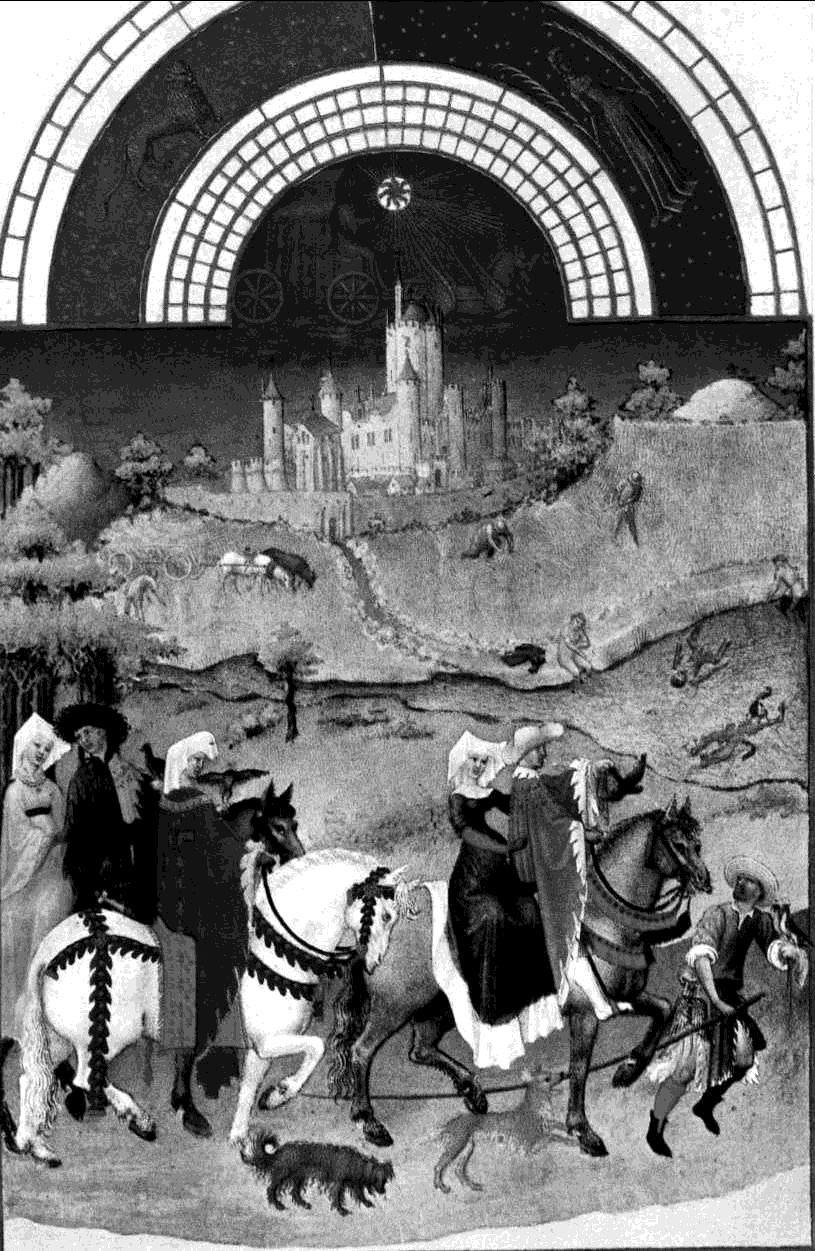 The Tres Riches Heures de le Duc de Berry is one of the best known of the late 14th-early 15th C. books of hours in the "Court of France" style. The first half of the book was painted by the famous Limbourg brothers (Paul, Hermann and Jean) under commission of the Duc de Berry (brother of King Charles V of France), between the years 1412 and 1416. In 1416, all three Limbourgs died in an epidemic, halting work on the book for several decades. The page here is from the well-known "zodiac calendar" which is the first set of pages in the book. The calendar page is that for the month of august (Figure 1). In the foreground is a groups of nobles out hawking. In the background are swimmers in a river, three peasants harvesting wheat, and the Chateau d'Etampes.
The Tres Riches Heures de le Duc de Berry is one of the best known of the late 14th-early 15th C. books of hours in the "Court of France" style. The first half of the book was painted by the famous Limbourg brothers (Paul, Hermann and Jean) under commission of the Duc de Berry (brother of King Charles V of France), between the years 1412 and 1416. In 1416, all three Limbourgs died in an epidemic, halting work on the book for several decades. The page here is from the well-known "zodiac calendar" which is the first set of pages in the book. The calendar page is that for the month of august (Figure 1). In the foreground is a groups of nobles out hawking. In the background are swimmers in a river, three peasants harvesting wheat, and the Chateau d'Etampes.
It is difficult to see the wheat and the wheat sheaves in
the greytone reproduction of the calendar page (Figure 1) attached here. Even in the color reproduction, the sheaves have little contrast with the surrounding wheat, both of which were painted in shades of yellow with red ochre detailing.
Click here to see a color version of August page from the Tres Riches Heures. Use your Back arrow or Back menu command to return to this web page.
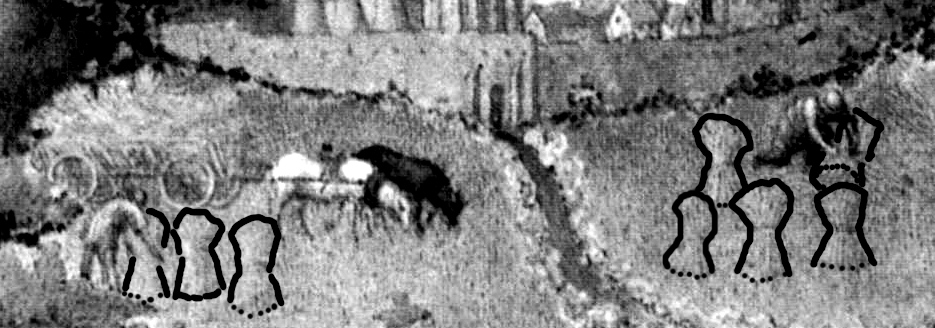 Figure 2 is a close-up of the peasants and the wheat, with the sheaves outlined in black to show their location in the painting. Like most gothic art, proportion, perspective and lighting are not rigorously realistic, as can be seen by the relative size of the two peasants bundling and loading the sheaves. Overall, however, it seems safe to estimate the size of the sheaves as being approximately half the height of a peasant, i.e. somewhere between two to three feet high, with a base that appears to be 1/3rd the height of the sheaf.
Figure 2 is a close-up of the peasants and the wheat, with the sheaves outlined in black to show their location in the painting. Like most gothic art, proportion, perspective and lighting are not rigorously realistic, as can be seen by the relative size of the two peasants bundling and loading the sheaves. Overall, however, it seems safe to estimate the size of the sheaves as being approximately half the height of a peasant, i.e. somewhere between two to three feet high, with a base that appears to be 1/3rd the height of the sheaf.
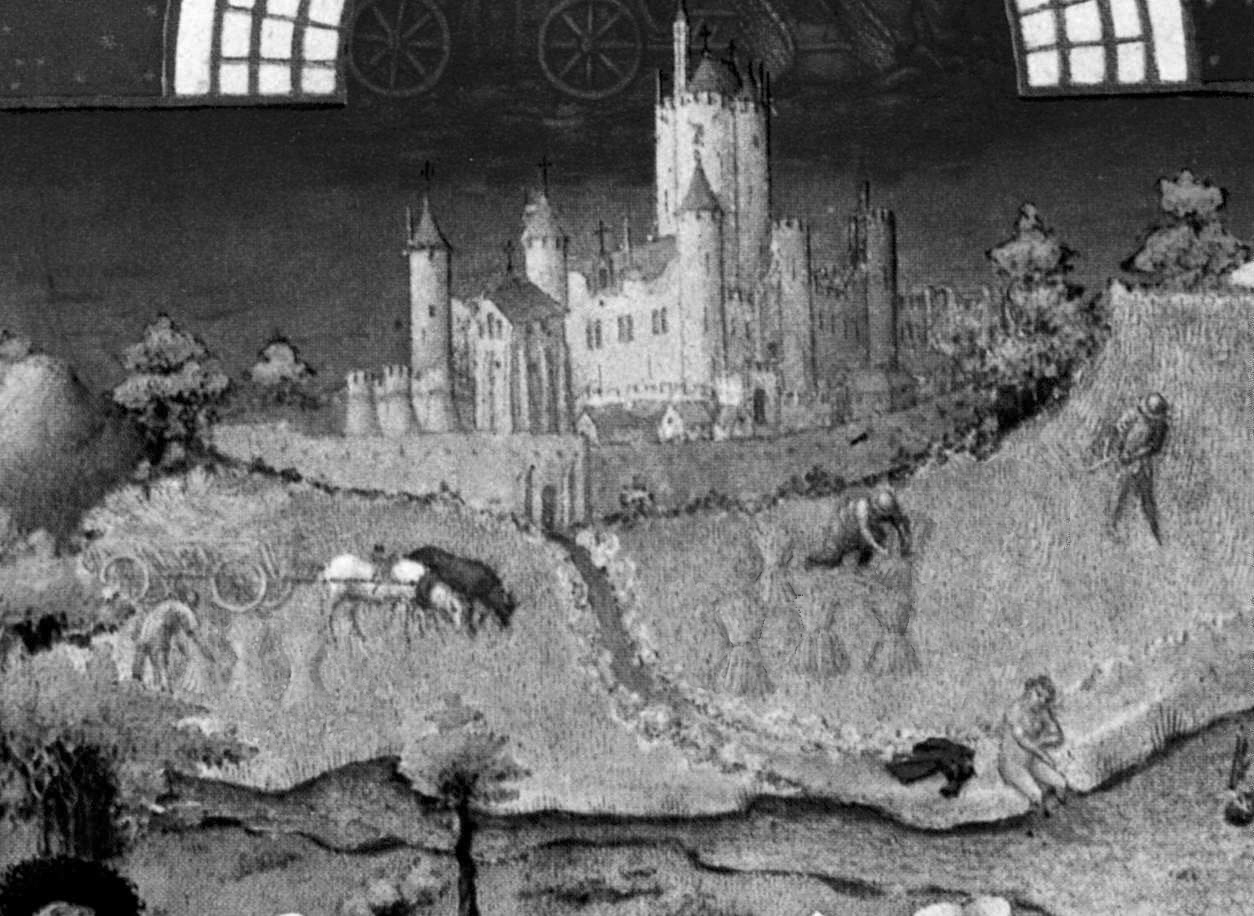 Figure 3 is a photo-enhanced close-up of the wheat field. The peasant to the left is picking up the garbs and throwing them in the hay wagon. The peasant to the right is cutting the wheat, and the middle peasant is bundling the wheat into garbs. From the posture of the middle peasant, it looks like he is exerting a reasonable amount of tension on whatever he is using to tie the cut wheat. What he is using to bind the wheat stalks together is not known.
Figure 3 is a photo-enhanced close-up of the wheat field. The peasant to the left is picking up the garbs and throwing them in the hay wagon. The peasant to the right is cutting the wheat, and the middle peasant is bundling the wheat into garbs. From the posture of the middle peasant, it looks like he is exerting a reasonable amount of tension on whatever he is using to tie the cut wheat. What he is using to bind the wheat stalks together is not known.
Information about the garb (fabrics used, explanation of changes, etc):
The peasants from the August calendar page of the Tres Riches Heures grew their own wheat. Lacking the land to plant a field of wheat, and the peasants to sow, till and reap it, I was constrained by time and labor costs to purchase my wheat from a farm in Montana. Not at all familiar with how much wheat one gets per pound of wheat ordered, I ordered several pounds from the farmer. I used 3 pounds of wheat to make my garb, since that was what I could get my hands around and carry before attempting to bind the stalks.
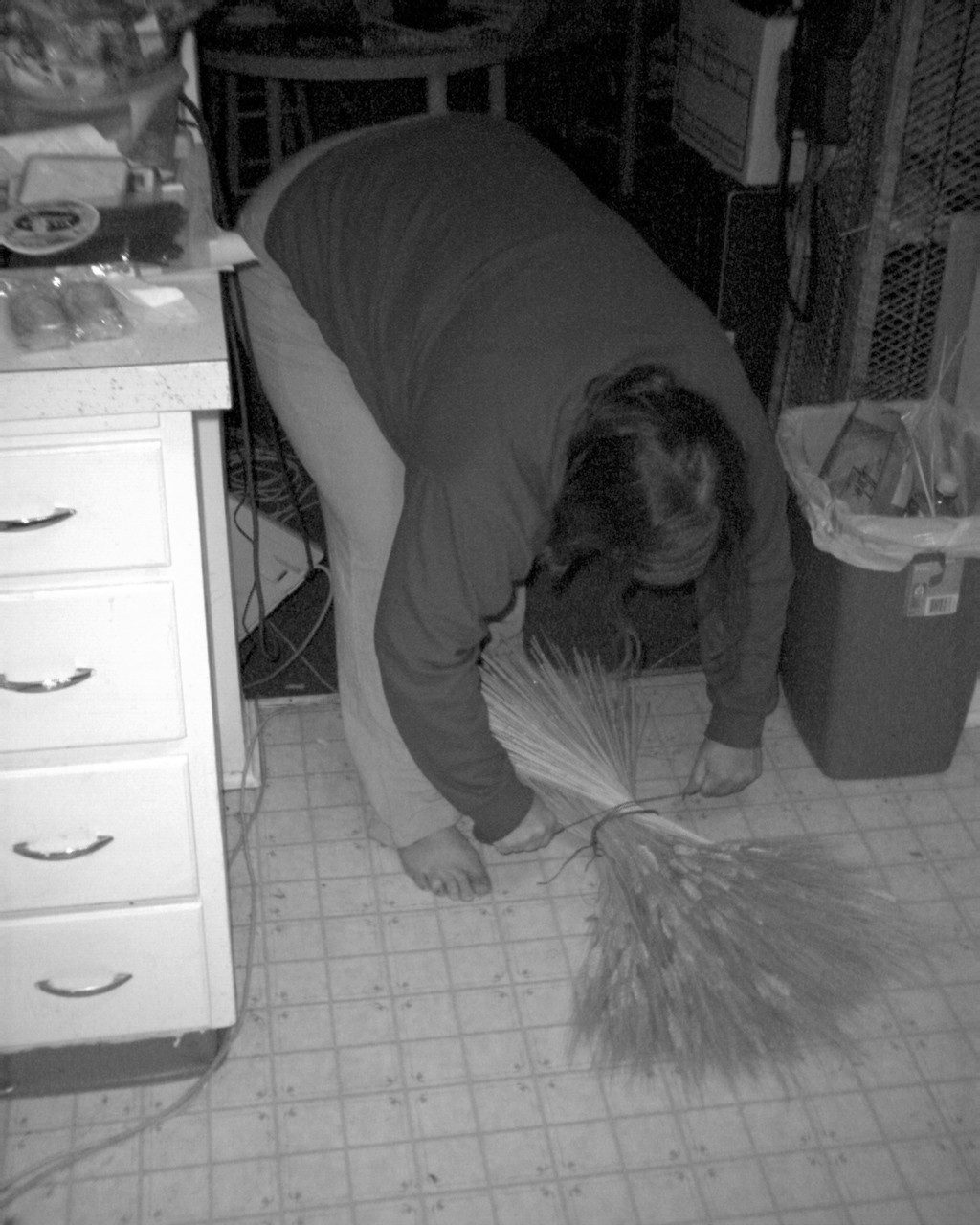 Initially I attempted to bind the wheat with a braid of wheat stalks, thinking that this would be a logical material, being free and abundantly available at the wheat field being harvested. This was not a feasible material, actually, even for a sheaf weighing as little as 1 pound. I then decided that a period twine or cord may have been used to bind a garb. Not being about to find my spool of hand-spun linen twine, I first tried silk suture thread, which was inadequate to the task of binding a 3 pound garb, much to my surprise. I then escalated to using a modern synthetic-fiber waxed twine, as the only thing left in the house strong enough to bind the garb. I did tie the garb with the assembled stalks on the ground, like the middle peasant from the August calendar page (Figure 4). Unlike the garbs from the Tres Riches Heures, I had to resort to two bindings at different levels or the garb would not stand up.
Initially I attempted to bind the wheat with a braid of wheat stalks, thinking that this would be a logical material, being free and abundantly available at the wheat field being harvested. This was not a feasible material, actually, even for a sheaf weighing as little as 1 pound. I then decided that a period twine or cord may have been used to bind a garb. Not being about to find my spool of hand-spun linen twine, I first tried silk suture thread, which was inadequate to the task of binding a 3 pound garb, much to my surprise. I then escalated to using a modern synthetic-fiber waxed twine, as the only thing left in the house strong enough to bind the garb. I did tie the garb with the assembled stalks on the ground, like the middle peasant from the August calendar page (Figure 4). Unlike the garbs from the Tres Riches Heures, I had to resort to two bindings at different levels or the garb would not stand up.
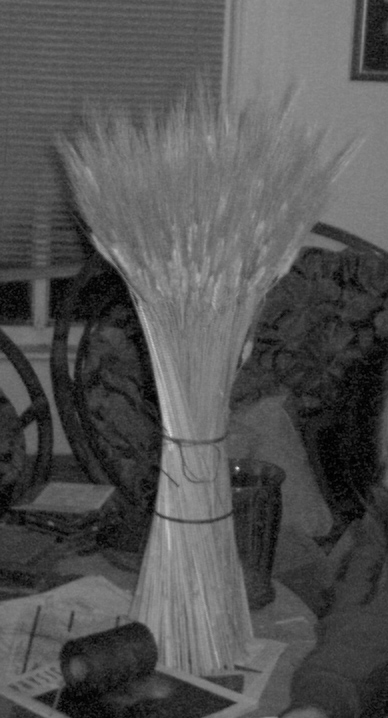 The garb has a small enough base, perhaps half of what's depicted in the Tres Riches Heures, that one binding did not result in sufficient stability for the garb to stand without falling over. It was not possible to prevent the stalks from spiraling during binding (Figure 5). I suspect that if I used more wheat, the spiraling may not happen while binding larger garbs.
The garb has a small enough base, perhaps half of what's depicted in the Tres Riches Heures, that one binding did not result in sufficient stability for the garb to stand without falling over. It was not possible to prevent the stalks from spiraling during binding (Figure 5). I suspect that if I used more wheat, the spiraling may not happen while binding larger garbs.
Why did you choose this piece?
The garbs in the Tres Riches Heures did not appear to be beyond my ability to construct, and the source itself is considered to portray an exceptionally accurate view of agricultural life during the late gothic.
Anything else you would like the judges to know?
First, my garb appears to be approximately a half to a third of the size of those from the Tres Riches Heures. My garb was basically limited by how much wheat I was able to assemble successfully for binding. Had I better agricultural skills, I think that binding a larger garb would be possible.
Next, my experience with making the garb has convinced me that the binding material used in period would have been a strong twine or cord. Even for a small 3 pound garb, I needed a strong modern twining to tie the wheat together, stronger even than my braided silk suturing cord. There is an independent line of evidence that garbs were bound with strong twine or cording, and that come from medieval heraldry. Heraldic garbs are said to be "banded," and if the banding is not the same color as the sheaf, then the banding color must be specified in the blazon. Unusual banding materials must also be specified in the blazon. Most default depictions of heraldic garbs show rope or cord in emblazons as the banding material.
Last, I must make a note of modern vs. medieval word usage with respect to this entry. A medieval garb was exclusively a sheaf of some grain or grass. In heraldic usage, the default grain in a garb became wheat, as is so abundantly demonstrated by the history of the arms of the Earls of Chester. On the other hand, the things that people wore were commonly referred to as either robes or clothes. For someone "to make and wear garb" in period would imply that some poor sod was trying clothe him- or herself by tying sheafs of wheat about his- or her midriffs.
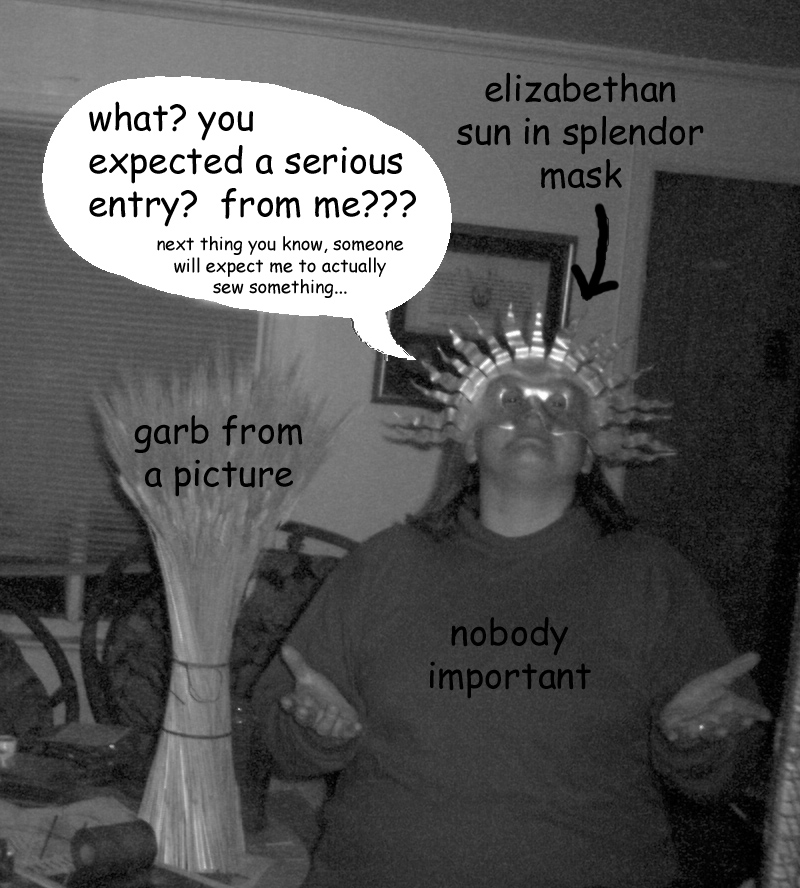
References
Avril, F., 1978, Manuscript Painting at the Court of France, Brazillier Books, NY.
Fox-Davies, A. C., 1986, The Art of Heraldry, Bloomsbury Books, London (reproduction of the original 1904 edition)
Harthan, J., 1977, The Book of Hours, Park Lane Books, NY.
Les Tres Riches Heures (photographic reproduction), 1976, Braizillier Books, NY.
Click here to see my rant on the inconsistencies of the judges of this competition.
Click here to return to my SCA Projects page.
Click here to return to my home page.
This page went on line November 10, 2002. This page was last modified on November 10, 2002. No ads. No cookies. No marketroids. No Spam. No junk email. No hassle. I spell badly and sometimes links die. Send comments about this site to: no1home@onewest.net. Thanks for stopping by.
 The Tres Riches Heures de le Duc de Berry is one of the best known of the late 14th-early 15th C. books of hours in the "Court of France" style. The first half of the book was painted by the famous Limbourg brothers (Paul, Hermann and Jean) under commission of the Duc de Berry (brother of King Charles V of France), between the years 1412 and 1416. In 1416, all three Limbourgs died in an epidemic, halting work on the book for several decades. The page here is from the well-known "zodiac calendar" which is the first set of pages in the book. The calendar page is that for the month of august (Figure 1). In the foreground is a groups of nobles out hawking. In the background are swimmers in a river, three peasants harvesting wheat, and the Chateau d'Etampes.
The Tres Riches Heures de le Duc de Berry is one of the best known of the late 14th-early 15th C. books of hours in the "Court of France" style. The first half of the book was painted by the famous Limbourg brothers (Paul, Hermann and Jean) under commission of the Duc de Berry (brother of King Charles V of France), between the years 1412 and 1416. In 1416, all three Limbourgs died in an epidemic, halting work on the book for several decades. The page here is from the well-known "zodiac calendar" which is the first set of pages in the book. The calendar page is that for the month of august (Figure 1). In the foreground is a groups of nobles out hawking. In the background are swimmers in a river, three peasants harvesting wheat, and the Chateau d'Etampes. Figure 2 is a close-up of the peasants and the wheat, with the sheaves outlined in black to show their location in the painting. Like most gothic art, proportion, perspective and lighting are not rigorously realistic, as can be seen by the relative size of the two peasants bundling and loading the sheaves. Overall, however, it seems safe to estimate the size of the sheaves as being approximately half the height of a peasant, i.e. somewhere between two to three feet high, with a base that appears to be 1/3rd the height of the sheaf.
Figure 2 is a close-up of the peasants and the wheat, with the sheaves outlined in black to show their location in the painting. Like most gothic art, proportion, perspective and lighting are not rigorously realistic, as can be seen by the relative size of the two peasants bundling and loading the sheaves. Overall, however, it seems safe to estimate the size of the sheaves as being approximately half the height of a peasant, i.e. somewhere between two to three feet high, with a base that appears to be 1/3rd the height of the sheaf.  Figure 3 is a photo-enhanced close-up of the wheat field. The peasant to the left is picking up the garbs and throwing them in the hay wagon. The peasant to the right is cutting the wheat, and the middle peasant is bundling the wheat into garbs. From the posture of the middle peasant, it looks like he is exerting a reasonable amount of tension on whatever he is using to tie the cut wheat. What he is using to bind the wheat stalks together is not known.
Figure 3 is a photo-enhanced close-up of the wheat field. The peasant to the left is picking up the garbs and throwing them in the hay wagon. The peasant to the right is cutting the wheat, and the middle peasant is bundling the wheat into garbs. From the posture of the middle peasant, it looks like he is exerting a reasonable amount of tension on whatever he is using to tie the cut wheat. What he is using to bind the wheat stalks together is not known. Initially I attempted to bind the wheat with a braid of wheat stalks, thinking that this would be a logical material, being free and abundantly available at the wheat field being harvested. This was not a feasible material, actually, even for a sheaf weighing as little as 1 pound. I then decided that a period twine or cord may have been used to bind a garb. Not being about to find my spool of hand-spun linen twine, I first tried silk suture thread, which was inadequate to the task of binding a 3 pound garb, much to my surprise. I then escalated to using a modern synthetic-fiber waxed twine, as the only thing left in the house strong enough to bind the garb. I did tie the garb with the assembled stalks on the ground, like the middle peasant from the August calendar page (Figure 4). Unlike the garbs from the Tres Riches Heures, I had to resort to two bindings at different levels or the garb would not stand up.
Initially I attempted to bind the wheat with a braid of wheat stalks, thinking that this would be a logical material, being free and abundantly available at the wheat field being harvested. This was not a feasible material, actually, even for a sheaf weighing as little as 1 pound. I then decided that a period twine or cord may have been used to bind a garb. Not being about to find my spool of hand-spun linen twine, I first tried silk suture thread, which was inadequate to the task of binding a 3 pound garb, much to my surprise. I then escalated to using a modern synthetic-fiber waxed twine, as the only thing left in the house strong enough to bind the garb. I did tie the garb with the assembled stalks on the ground, like the middle peasant from the August calendar page (Figure 4). Unlike the garbs from the Tres Riches Heures, I had to resort to two bindings at different levels or the garb would not stand up.
 The garb has a small enough base, perhaps half of what's depicted in the Tres Riches Heures, that one binding did not result in sufficient stability for the garb to stand without falling over. It was not possible to prevent the stalks from spiraling during binding (Figure 5). I suspect that if I used more wheat, the spiraling may not happen while binding larger garbs.
The garb has a small enough base, perhaps half of what's depicted in the Tres Riches Heures, that one binding did not result in sufficient stability for the garb to stand without falling over. It was not possible to prevent the stalks from spiraling during binding (Figure 5). I suspect that if I used more wheat, the spiraling may not happen while binding larger garbs.